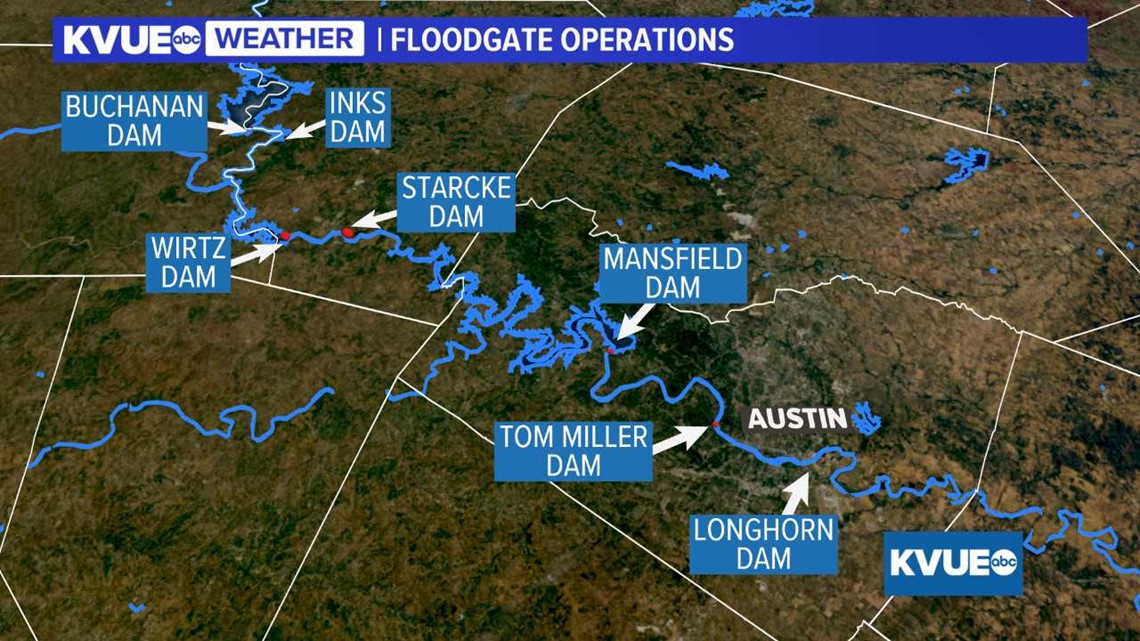AUSTIN — Over the past few days the Highland Lakes chain has been inundated with a large amount of water and that water has moved into Lake Travis, where four flood gates have been opened on Mansfield Dam as of Thursday. Up to eight flood gates could be opened over the next few days, which would be the highest amount of flood gates opened in the history of the dam. This could lead to damage of property downstream, into the Lake Austin and Lady Bird Lake region.
Since Monday, some dams in the region have opened up all of their flood gates, to relieve flooding on the communities above the dam, but this leaves the water rushing and impacting areas below each dam.
We have seen this problem stretching from well up the Llano and Colorado River, into Lake LBJ, Lake Marble Falls, Lake Travis, Lake Austin, Lady Bird Lake, and all of the rivers and waterways in-between.
The excessive flooding has caused damage to property along the waterways, and the flooding concern is not over yet.
While communities well up river around Granite Shoals, Kingsland, and Llano are able to start cleaning up, the flooding concerns are growing around Lake Travis, Lake Austin, Lady Bird Lake, and further downstream as the water continues to flow through the dams.
According to the Lower Colorado River Authority's website, they manage a 600 mile stretch of the Texas Colorado River stretching from San Saba to the Gulf Coast.
They operate six dams, including Buchanan, Inks, Wirtz, Starke, Mansfield and Tom Miller. The six dams create the Highland Lakes, which are Lake Buchanan, Lake LBJ, Lake Marble Falls, Lake Travis and Lake Austin.


Related:
The lakes and dams are used for multiple reasons, including to reduce the likelihood of flood damage.
With so many lakes and dams used to relieve flooding, why is there still so much flooding?
The LCRA website states, "The Hill Country and Central Texas have a greater risk of flash flooding than most regions of the United States. The region of Texas is called Flash Flood Alley because of the area's steep terrain, shallow soil and unusually high rainfall rates."
With the high amount of rain that fell earlier in the week throughout the Hill Country, all of the rain water filtered into canyons and valleys, and eventually into creeks and rivers. As of Thursday, much of the flood waters filled Lake Travis to a point where LCRA officials are considering opening up four additional flood gates at Mansfield Dam over the next few days.
Opening eight flood gates at once could lead to impacts downstream into Lake Austin and Lady Bird Lake as flooding and swift water would become a big concern to property owners along the waterways.
The LCRA plans for how much water to send through a dam to keep the amount of damage across the region lower. While sending more water through a dam could cause some damage downstream, it could save more communities total, and prevent a larger amount of widespread damage.
As of Thursday, Mansfield Dam had four flood gates open, but water continues to rise in Lake Travis. Additional floodgates at Mansfield Dam are not expected to open on Thursday, but more could be opened over the next few days, leading to the flooding concerns along Lake Austin, Ladybird Lake, and further downstream.
If you live along or near one of these major waterways, be sure to stay updated on what the water levels are doing.
You can find out more information on the current conditions on the highland lakes, here.
You can find out the latest information on rainfall totals, stream flow, and lake levels, here.

